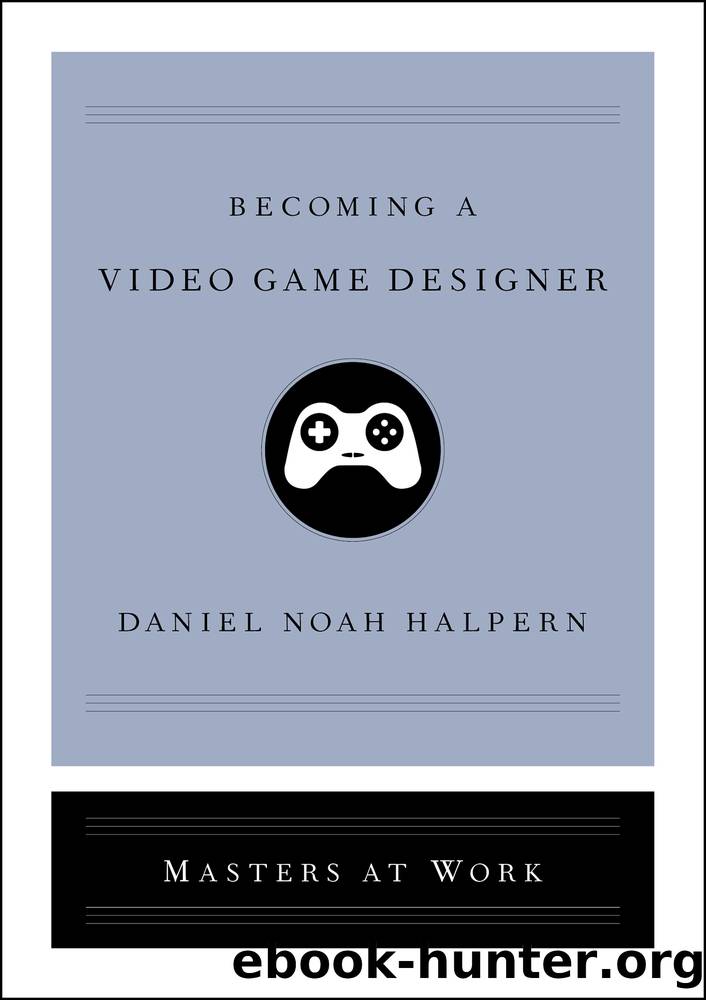Becoming a Video Game Designer by Daniel Noah Halpern

Author:Daniel Noah Halpern
Language: eng
Format: epub
Publisher: Simon & Schuster
Published: 2020-12-02T00:00:00+00:00
* * *
So: âa game has rulesâ is pretty simple. But how about Huizingaâs third rule, that play is not ordinary life, but an unreal space? Here is Huizingaâs description: âThe arena, the card-table, the magic circle, the temple, the stage, the screen, the tennis court, the court of justice, etc., are all in form and function play-grounds, i.e., forbidden spots, isolated, hedged round, hallowed, within which special rules obtain. All are temporary worlds within the ordinary world, dedicated to the performance of an act apart.â Zimmerman has written extensively about this space, this temporary, special space that exists apart from our normal reality; he named it, using it as a general principle, âthe magic circle.â The magic circle, he told me, âis a finite space with infinite possibility.â But what does that mean, infinite possibility? What, exactly, is an unreal space? And how do you make one?
Stone Librande, who is a lead designer at Riot, boiled down the problem for me. Librande lives in the Bay Area (âRiot Northâ), and also teaches a game design workshop for students in Carnegie Mellon Universityâs Entertainment Technology Center. Riotâs URF Academy curriculum is based on his college course. Students start with pen and paper, no other technology. This is in part because Librande believes the game mechanics are the core of the creationâhe sees the overlay of technology as floors built over the foundation. Among the basic concepts in his course, he said, is the idea that âIf you really think about playing a video game, brutally honestly, youâre saying, âIâm going to go home and Iâm going to hold on to a piece of plastic and tap my thumb against the plastic while I look at colored lights change on a piece of glass.âââ So the trick of the game is to convince you youâre not just tapping plastic buttons on your couch: youâre fighting aliens, youâre shooting Nazis, youâre building a farm, youâre throwing a pass, youâre shooting blue fire out of your butt. âThatâs the main video game design trick,â Librande said. âHow do you map aesthetics and feelings and emotions onto mechanical risk-reward, Pavlovian behavioral systems?â
Thatâs part of the magic circle: youâre a cowboy on a horse. For a time. For those moments, those hours, youâre there: youâre not sitting on a couch. Youâre in a saddle, in a magic space. The normal rules of lifeâthe normal chaos of lifeâdo not apply. Surely some of this is achieved with art and technology: extraordinary vistas, evocative music, angles of perspective, photo-realism, even virtual realities. But its foundation is in the mechanics of the game. Almost all the designers I met agreed that for all the story and art and technology, the simple core of what makes games games was providing the player with the act of making choices. Without that act, without the chance to make engaged decisions that affect how the experience proceeds, you have a movie or a book or a painting that you are external to. You are not making decisions about where the book or movie will go.
Download
This site does not store any files on its server. We only index and link to content provided by other sites. Please contact the content providers to delete copyright contents if any and email us, we'll remove relevant links or contents immediately.
Sapiens: A Brief History of Humankind by Yuval Noah Harari(14212)
The Tidewater Tales by John Barth(12595)
Mastermind: How to Think Like Sherlock Holmes by Maria Konnikova(7195)
Do No Harm Stories of Life, Death and Brain Surgery by Henry Marsh(6875)
The Thirst by Nesbo Jo(6809)
Why We Sleep: Unlocking the Power of Sleep and Dreams by Matthew Walker(6597)
Life 3.0: Being Human in the Age of Artificial Intelligence by Tegmark Max(5447)
Sapiens by Yuval Noah Harari(5281)
The Longevity Diet by Valter Longo(5007)
The Body: A Guide for Occupants by Bill Bryson(4953)
The Rules Do Not Apply by Ariel Levy(4823)
The Immortal Life of Henrietta Lacks by Rebecca Skloot(4502)
Animal Frequency by Melissa Alvarez(4382)
Why We Sleep by Matthew Walker(4342)
The Hacking of the American Mind by Robert H. Lustig(4304)
Yoga Anatomy by Kaminoff Leslie(4289)
All Creatures Great and Small by James Herriot(4213)
Double Down (Diary of a Wimpy Kid Book 11) by Jeff Kinney(4179)
Barron's AP Biology by Goldberg M.S. Deborah T(4081)
